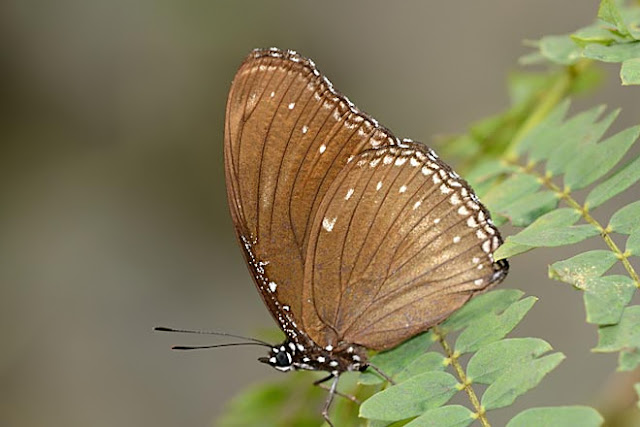We were fortunate to have a rather nice, in fact hot Saturday morning (24 Nov) in this monsoon season. Thanks BJ for initiating this outing and giving me a lift to this wild place somewhere along Yeo Chu Kang Road.
Except for a short concealed path, I was rather surprised to see there are well-conditioned tarred road in this "no-man's" land. We strolled leisurely, looking out for butterflies and hoping that some durians high on the trees would drop in front of us.
The very first butterfly came to our notice was this male Malayan Eggfly form-nivas (Hypolimnas anomala anomala).
The very first butterfly came to our notice was this male Malayan Eggfly form-nivas (Hypolimnas anomala anomala).
It has been a long time since my last sighting of this form in the wild. The underside of this form is characterised by a patch of diffused post-discal white streaks on the hindwing.
This is form-anomola which is more commonly seen in the wild.
Females lay many eggs, clustered together and usually underneath a leaf. If you are observant, you may find a large group of larvae on the host plant but I guess only a fraction of them survive ultimately as I have never seen a sizable colony of the adults in the wild so far.
There were a few lycaenids puddling on the gravel ground but waiting for them to stay still in the hot sun was a torturing experience. This is my only lucky shot of a Ciliate Blue (Anthene emolus goberus) which happened to stop in front of me while I was chasing another puddling lycaenid.
We ventured quite far away from where we started. Nice scenery at a few spots and a solitary Dark Glassy Tiger (Parantica agleoides agleodies) was found feeding on the Bidens flowers.
At another location, a few butterflies were puddling but they were extremely skittish and never stayed still on one spot. This Common Bluebottle (Graphium sarpedon luctatius) just refused to let me go closer.
A rather small and different grasshopper with some green patches was resting on a grass blade.
There were quite a number of different dragonflies at a few locations. This beautiful blue dragonfly is a male Common Blue Skimmer (Orthetrum glaucum). Though it was alert and active, we could still snap a few shots as they had the tendency to come back to its previous perch.
There were quite a number of dragonflies at different locations. A couple of Coastal Glider (Macrodiplax cora)
There were many species of wild flowers in the area. I am sure you find the shape of this flower interesting and the colours attractive. What is this ?
I have seen this attractive flowers of a climber on beaches.
This flower also attracted skippers to feed on them. After feeding, this brown Pelopidas species rested on the flower.
I will visit this place again and hopefully take more pictures of the wild plants and flowers growing on this huge "no-man's land".











.jpg)



Is this the Seletar Simpang Area?
ReplyDeleteAlong Yeo Chu Kang Road. Check Google map and you can guess. Enter at your own risk. :-)
ReplyDelete@ From post: "There were many species of wild flowers in the area. [...] What is this ?"
ReplyDeleteYour photo of the bi-toned blue flower shows Torenia fournieri (Bluewigs, Wishbone Flower), which is native to Indochina.
This species & its cultivars are sometimes cultivated as bedding groundcovers in S'pore. The plant self-seeds easily, & can be encountered in the wild here.
* Photos (Plant Observatory SG)
* Info & Photo (Missouri Botanical Garden: Plant Finder)
@ From post: "I have seen this attractive flowers of a climber on beaches."
Your photo of the pink flowers show Canavalia rosea [syn. C. maritima] (Bay Bean, Beach Bean, Kacang Laut) -- a common native coastal species of S'pore.
* Info & Photos (FloraBase)
* Photos (TideChaser - 08 Apr 2012)
* Info & Photos (Wild S'pore Factsheet - 13 Jan 2008)
* USDA GRIN Taxonomy
* ILDIS World Database of Legumes
Canavalia cathartica (Maunaloa, Poisonous Sea Bean) is a similar-looking creeper-climber with pale pink flowers. This is also a common native species.
Canavalia lineata (Thunb.) DC. (Hama-nata-mame, Perennial Pea) is another lookalike coastal species, which is frequently-confused (& depicted interchangeably) with Canavalia rosea [syn. C. lineata auct. non (Thunb.)] -- where "auct. non" denotes "misapplied".
Unlike Canavalia rosea, C. lineata is characterized by the presence of a distinct fold-indent on the middle of the banner (ie. upper) flower petal. In addition, this species has a more northerly distribution -- it is found in Southern China, Taiwan, Southern Japan, South Korea, Indochina & the Philippines. In its native range, the plant blooms during late spring & early summer (May to July).
Some photos & info for Canavalia lineata:
* Prof. Summer's Web Garden: Japanese Wild Flowers
* Okayama University of Science
* Forest Tree Breeding Center, Forestry & Forest Products Research Institute (FFPRI)